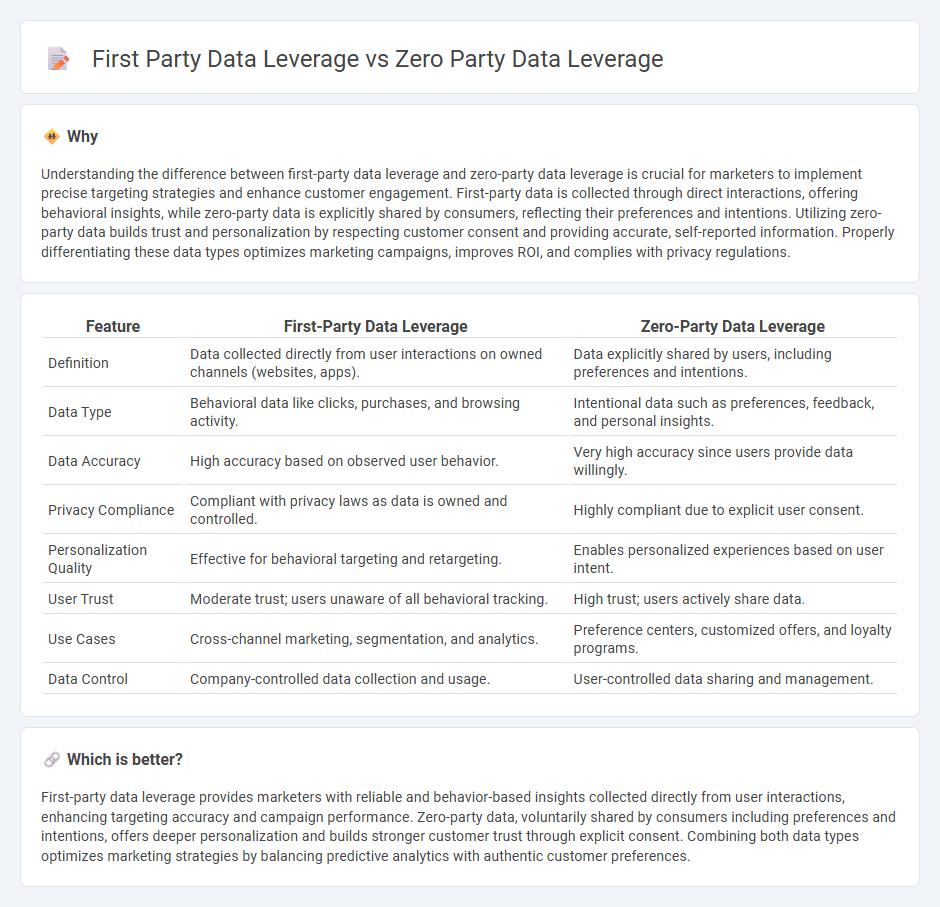
First party data leverages information collected directly from customer interactions, including website visits, purchase history, and CRM data, enabling personalized marketing strategies grounded in actual behavior. Zero party data involves explicit information voluntarily shared by customers, such as preferences and intentions, offering highly accurate insights for tailored campaigns and improving customer trust through transparency. Discover how utilizing both data types can revolutionize your marketing effectiveness and customer engagement strategies.
Why it is important
Understanding the difference between first-party data leverage and zero-party data leverage is crucial for marketers to implement precise targeting strategies and enhance customer engagement. First-party data is collected through direct interactions, offering behavioral insights, while zero-party data is explicitly shared by consumers, reflecting their preferences and intentions. Utilizing zero-party data builds trust and personalization by respecting customer consent and providing accurate, self-reported information. Properly differentiating these data types optimizes marketing campaigns, improves ROI, and complies with privacy regulations.
Comparison Table
| Feature | First-Party Data Leverage | Zero-Party Data Leverage |
|---|---|---|
| Definition | Data collected directly from user interactions on owned channels (websites, apps). | Data explicitly shared by users, including preferences and intentions. |
| Data Type | Behavioral data like clicks, purchases, and browsing activity. | Intentional data such as preferences, feedback, and personal insights. |
| Data Accuracy | High accuracy based on observed user behavior. | Very high accuracy since users provide data willingly. |
| Privacy Compliance | Compliant with privacy laws as data is owned and controlled. | Highly compliant due to explicit user consent. |
| Personalization Quality | Effective for behavioral targeting and retargeting. | Enables personalized experiences based on user intent. |
| User Trust | Moderate trust; users unaware of all behavioral tracking. | High trust; users actively share data. |
| Use Cases | Cross-channel marketing, segmentation, and analytics. | Preference centers, customized offers, and loyalty programs. |
| Data Control | Company-controlled data collection and usage. | User-controlled data sharing and management. |
Which is better?
First-party data leverage provides marketers with reliable and behavior-based insights collected directly from user interactions, enhancing targeting accuracy and campaign performance. Zero-party data, voluntarily shared by consumers including preferences and intentions, offers deeper personalization and builds stronger customer trust through explicit consent. Combining both data types optimizes marketing strategies by balancing predictive analytics with authentic customer preferences.
Connection
First-party data leverage and zero-party data leverage connect through their emphasis on direct consumer interactions, enabling brands to gather accurate and personalized insights. Utilizing first-party data involves collecting behavior-based information from customers, while zero-party data focuses on explicitly shared preferences and intentions. Together, these data types enhance targeted marketing strategies and drive effective customer engagement.
Key Terms
Consent
Zero party data leverage emphasizes explicit customer consent, as users willingly share personal preferences and intentions, ensuring maximum transparency and trust. First party data leverage relies on data collected through user interactions and behaviors on owned channels, often requiring careful management of implicit consent under privacy regulations. Explore how adopting zero party data strategies can enhance compliance and user engagement.
Personalization
Zero-party data leverages directly shared information from customers, enabling hyper-personalized experiences based on explicit preferences, intentions, and context without relying on inferred or behavioral data. First-party data, collected through user interactions, browsing behavior, and purchase history, supports personalization through analyzed patterns but may lack the explicit consent and clarity zero-party data offers. Explore how integrating zero-party data can elevate your personalization strategy beyond traditional first-party data methods.
Data Ownership
Zero-party data offers unparalleled data ownership as it is willingly and proactively shared by users, ensuring complete transparency and consent. First-party data is collected through user interactions and behaviors on owned platforms, maintaining strong data control but with less explicit user intent than zero-party data. Explore how leveraging these data types can enhance your data ownership strategy.
Source and External Links
Zero-Party Data vs. First-Party Data: The Differences - Explores how zero-party data allows for explicit insights into customer preferences, enhancing personalization and trust through direct customer input.
How would Zero-party Data Impact brands? - Discusses how zero-party data enables hyper-personalization, builds trust, and improves data accuracy by directly involving customers in sharing their preferences.
Why Zero-Party Data Matters for Marketers & Produc - Highlights the strategies and benefits of leveraging zero-party data for personalized marketing and enhanced customer experiences.
 dowidth.com
dowidth.com